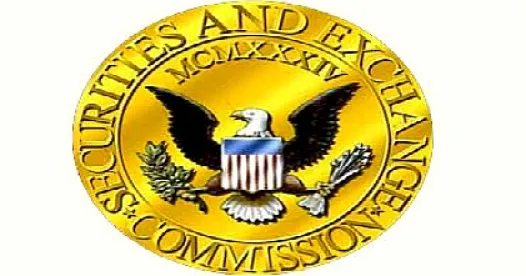On June 22, 2011, the Securities and Exchange Commission (“SEC”) held an open meeting on amendments to the Investment Advisers Act of 1940, as amended (the “Advisers Act”) to implement provisions of Title IV of the Dodd-Frank Wall Street Reform and Consumer Protection Act (the “Dodd-Frank Act”). At the meeting, the SEC adopted numerous rule proposals—some by a contested three-to-two vote and the others unanimously. The adopted rules bring clarification to advisers of hedge funds, private equity funds, venture capital and other privately offered funds on the timing of registration and the scope of potential exemptions. The adopted rules also clarify the timing and registration requirements for foreign private advisers, mid-sized advisers and family offices. The adopted rules include amendments to Form ADV to incorporate the various registration changes and to implement and address certain interpretive questions under the new and amended exemptions and exclusions under the Advisers Act.
An archived webcast of the open meeting may be found at the following link: http://www.sec.gov/news/openmeetings/2011/062211openmeeting.shtml. As we continue to digest the recently adopted rules, we are likely to publish a more detailed analysis in the near future.
Private Fund Advisers
The Dodd-Frank Act generally extended the Advisers Act registration requirements to advisers to hedge funds, private equity funds and other private funds by repealing the current private adviser exemption (Section 203(b)(3)—the fewer-than-15 client exemption). The Dodd-Frank Act, through new Section 203(m) of the Advisers Act, required the SEC to adopt a private fund adviser exemption for advisers solely to private funds that have less than $150 million in assets under management. Rule 203(m)-1, which the SEC adopted at the open meeting, provides this exemption and addresses certain interpretive questions raised by Section 203(m). A summary of the Rule and the revised Form ADV instructions is set forth below.
- An adviser may advise an unlimited number of private funds, but is not eligible for the exemption if it has one or more clients that are not private funds.
- A private fund includes Sections 3(c)(1) and 3(c)(7) funds under the Investment Company Act of 1940, as amended (the “Investment Company Act”). It also includes other funds that qualify for an exclusion from the definition of investment company under Section 3 of the Investment Company Act in addition to Sections 3(c)(1) and 3(c)(7).
- An adviser relying on the exemption must have aggregate assets of private funds below the $150 million threshold, calculated annually. The value of the private fund assets must be computed in accordance with revised Form ADV instructions adopted at the open meeting. The computation is based on gross assets and includes proprietary assets, assets managed without compensation and, importantly for private equity managers, uncalled capital commitments.
- In the case of a non-U.S. adviser, the exemption is available only as long as all of the adviser’s U.S. clients are qualifying private funds. The number or nature of non-U.S. clients or assets does not affect the analysis.
Registration Timing for Private Fund Advisers
While the former private adviser exemption (i.e., the fewer-than-15 client exemption) is being repealed as of July 21, 2011, the SEC is not requiring advisers who were entitled to rely on the former private adviser exemption as of July 20, 2011 to register until March 30, 2012. Accordingly, advisers who are no longer exempt will need to file a registration on Form ADV by February 14, 2012 in order to have their registration effective by March 30.
Mid-Sized Advisers
The Dodd-Frank Act created a “mid-sized” adviser category under Section 203A(a)(2) of the Advisers Act. Mid-sized advisers include advisers with between $25 million and $100 million in assets under management. If a mid-sized adviser has less than $100 million in assets under management, it must register with the states and is prohibited from registering with the SEC unless the adviser is not “required to be registered” in the state of its principal place of business or is not subject to examination authority in the state of its principal place of business. The SEC estimates 3,200 advisers will need to transition from registering with the SEC to state registration.
The rule amendments adopted at the open meeting include amendments to the instructions to Form ADV that are intended to clarify when an adviser is not required to be registered with a state and is not subject to examination authority. Generally, if the mid-sized adviser is located in Wyoming, which does not have an investment adviser statute, or is in a state that does not have an adviser examination program such as New York and Minnesota, the mid-sized adviser will have to register with the SEC. In addition, if a mid-sized adviser is exempt from state registration it will need to register with the SEC. Advisers with less than $25 million in assets under management who are not required to register with a state are not required to register with the SEC.
Registration Buffer—Intended to Limit Switching
Rule 203A-1 includes a registration buffer such that SEC registration is not required for a mid-sized adviser until an adviser exceeds $110 million in assets. Between $100 million and $110 million, registration with the SEC is voluntary. Conversely, an adviser need not withdraw its SEC registration until its assets are less than $90 million.
Determination of Federal or State Registration and Transition Timing
- Existing Mid-Sized Registrants—Every registered adviser as of January 1, 2012 must file an amendment to its Form ADV, Part 1 no later than March 30, 2012 to confirm whether it is entitled to remain registered with the SEC.
- No Longer Eligible—After the 2012 filing, mid-sized advisers that are no longer eligible to register must withdraw their federal registration no later than June 28, 2012.
- Transition to State Registration Period—Mid-sized advisers registered as of July 21, 2011 must remain federally registered until January 1, 2012. Prior to July 21, 2011, a mid-sized adviser may apply for SEC registration or register with a state. After July 21, 2011, mid-sized advisers are prohibited from registering with the SEC.
- Switching to State Registration—Except for the initial transition period in 2012, an SEC registered adviser will be required to apply for state registration within 180 days of its fiscal year-end after filing an annual ADV amendment indicating that it is no longer qualified to register with the SEC.
- Switching to SEC Registration—A state registered adviser will be required to apply for SEC registration within 90 days of the annual filing of its Form ADV.
As state laws are amended in response to the SEC’s final rules, advisers will need to pay particular attention to the new state registration requirements to the extent they have less than $100 million in assets.
Venture Capital Fund Advisers
The Dodd-Frank Act also required the SEC to provide an exemption from registration for venture capital fund advisers. To rely on the exemption under Section 203(l), the adviser must solely advise venture capital funds. At the open meeting, the SEC adopted Rule 203(l)-1 to define venture capital fund for purposes of the exemption. It appears both U.S. and non-U.S. advisers will be able to rely on Section 203(l) provided they advise only venture capital funds. For purposes of the new exemption, a “venture capital fund” is defined as a fund that:
- invests primarily in direct equity investments in qualifying portfolio companies;
- holds no more than 20 percent of its committed capital in a basket of “nonqualifying investments” exclusive of short-term obligations;
- limits borrowings to short-term borrowings (i.e., 15 percent of its committed capital and outstanding for no more than 120 days);
- does not offer its investors redemption or other similar liquidity rights except in extraordinary circumstances;
- represents itself to its investors and prospective investors as pursuing a venture capital strategy; and
- is not registered under the Investment Company Act and has not elected to be treated as a business development company.
Rule 203(l)-1 also includes a grandfathering provision. It provides that any pre-existing venture capital fund is deemed grandfathered and therefore a “venture capital fund” if it satisfies the following criteria:
- represented itself at the time of offering as a fund that pursues a venture capital strategy;
- sold securities prior to December 31, 2010; and
- does not sell any securities or accept capital commitments from any person after July 21, 2011.
Foreign Private Adviser Exemption
The Dodd-Frank Act replaced the current private adviser exemption with a new foreign private adviser exemption. The exemption appears in Section 203(b)(3) of the Advisers Act. Non-U.S. advisers may rely on either the foreign private adviser exemption or the new private fund adviser exemption, Section 203(m) and Rule 203(m)-1 described above, to avoid SEC registration. Section 202(a)(30) of the Advisers Act defines “foreign private adviser” to include:
- an adviser with no place of business in the United States;
- has, in total, fewer than 15 clients in the United States and private fund investors in the United States;
- aggregate assets under management attributable to clients in the United States and private fund investors in the United States of less than $25 million; and
- does not hold itself out to the public in the United States as an investment adviser.
The Commissioners noted during the open meeting that the SEC guidance provided in the Unibanco no-action letter regarding the interpretation of “participating affiliates” should remain in effect.
Family Offices
In response to the Dodd-Frank Act’s repeal of the current private adviser exemption upon which many family offices currently rely, the SEC adopted Section 202(a)(11)(G), which provides an exclusion from registration for family offices, as defined by the SEC, that are not investment advisers subject to the Advisers Act. At the open meeting, the SEC adopted Rule 202(a)(11)(G)-1, which defines the term “family office.” A family office that meets the definition in the new Rule is excluded from the definition of “investment adviser” under the Advisers Act. The family office must meet three conditions to claim the exclusion set forth in Rule 202(a)(11)(G)-1:
- provide securities advice only to family clients;
- family clients must wholly own the family office and family members and/or family entities must control the family office; and
- the family office must not hold itself out to the public as an investment adviser.
Definitions of Family Member and Family Clients
There was substantial debate regarding the definition of family member and family client in the proposed rule. These terms in the adopted Rule did not vary substantially from the proposal in October 2010. However, in Rule 202(a)(11)(G)-1 as adopted, the term “family member” was expanded to include former family members such as spouses as well as adopted children and stepchildren. The Rule also adds a requirement that limits family members to lineal descendants of a common ancestor who is no more than ten generations removed from the youngest generation of family members.
The definition of “family clients” has been broadened from the proposed rule to include common estate planning vehicles and charitable giving plans. Under the adopted Rule, “family clients” includes current and former family members, certain employees of the family office (and, under certain circumstances, former employees), charities funded exclusively by family clients, estates of current and former family members or key employees, trusts existing for the sole current benefit of family clients or, if both family clients and charitable and nonprofit organizations are the sole current beneficiaries, trusts funded solely by family clients, revocable trusts funded solely by family clients, certain key employee trusts, and companies wholly owned exclusively by, and operated for the sole benefit of, family clients (with certain exceptions).
Grandfathering
The grandfathering provision under the Rule was adopted substantially as proposed. The Dodd-Frank Act required the SEC to include within the definition of “family office” certain types of clients engaged by the family office prior to January 1, 2010. The grandfathering provision permits, subject to certain limitations, the definition of family office to include three types of clients who may not otherwise qualify as permissible “family clients” under the new Rule. The three clients include:
- officers, directors and employees of the family office who are accredited investors;
- a company owned exclusively by one or more family members; and
- any investment adviser registered under the Advisers Act that provides investment advice to the family office and who identifies investment opportunities to the family office, and co-invests in such transactions on substantially the same terms, but does not invest in other funds advised by the family office, and whose assets as to which the family office directly or indirectly provides investment advice represents, in the aggregate, less than 5 percent of the value of the total assets as to which the family office provides investment advice. If relying on this provision, the family office will be subject to the anti-fraud requirements of the Advisers Act (Section 206(1), (2) and (4)).
Multifamily Offices
As adopted, multifamily offices will not be permitted to claim the exclusion and along with other family offices that have non-family member clients will likely need to restructure in order to avoid SEC registration.
Involuntary Transfer of Assets to Non-Family Client
An involuntary transfer of assets to a non-family client (e.g., a bequest to a friend) by the family office can void the family office exclusion. Rule 202(a)(11)(G)-1 provides a one-year period during which the family office may continue to provide advice with respect to such assets following an involuntary transfer. The one-year period is intended to provide an orderly transition period to transfer the assets to another adviser or restructure the family office in a manner that meets the exclusion.
Family Charities with Donations from Non-Family Members
If a family office advises a nonprofit or charitable organization that has accepted non-family client funding, it may nevertheless rely on the exclusion in the Rule until December 31, 2013, provided that no additional funding from non-family clients is accepted after August 21, 2011 except in fulfillment of a pledge made before August 21, 2011.
Registration Timing for Non-Exempt Family Offices
Family offices that cannot meet the definition of a “family office” under the Rule are required to register with the SEC by March 30, 2012. Family offices that do not meet the definition may seek exemptive relief from registration.
Exempt Reporting Advisers—Private Fund and Venture Capital Adviser Exemption
The Dodd-Frank Act mandated that advisers exempt from SEC registration under the private fund or venture capital exemptions discussed above must file reports with the SEC. Exempt advisers will need to file portions of Part 1 of Form ADV with the SEC, which will be publicly available. In addition, the exempt advisers are required to maintain certain records. At the open meeting, Chairman Shapiro noted that while such exempt advisers may not be subject to routine examination, the SEC may examine these advisers. Non-U.S. advisers relying on the foreign private adviser exemption would not be required to file.
FEDERAL TAX NOTICE: Treasury Regulations require us to inform you that any federal tax advice contained herein is not intended or written to be used, and cannot be used, by any person or entity for the purpose of avoiding penalties that may be imposed under the Internal Revenue Code.




 />i
/>i


